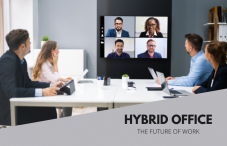Covid pandemic pushed organisations to adapt to new ways of working. Workplaces are evolving to accommodate the new normal. Many organisations are moving to something called a Hybrid office.
What is a Hybrid Workplace?
A hybrid workplace is a workplace that combines remote working and physical in-office working. What it means is that employees have the freedom to decide where and when they work.
There are various ways in which companies can implement a hybrid workplace model
All employees can work remotely for a few days a week or some employees can work remotely, and others can work regularly for all days. In another scenario, all employees can work remotely at all times and only meet for physical meetings when required.
There are various ways in which the model can work, depending on the needs of the organisation. The idea behind implementing this model is to find an equilibrium that aligns the needs of employees to work at their own time and space with technology to allow collaborations that lead to higher productivity & efficiency.
The hybrid working model works for both employers and employees.
For employers
As the dynamics of the workplace change due to the pandemic, companies are realising that more and more employees are looking for a greater work-life balance. 9 to 5 work shift is a thing of the past. Remote working is not just a ‘good to have’ anymore. While Younger Gen Z employees are looking for options where they can create a physical bond with their team members at the office and at the same time, enjoy the freedom to work remotely as and when they can, millennials are keener on working remotely with more personal and family time.
The hybrid workspace also allows companies to reshape their existing office infrastructure taking into consideration the new social distancing norms. Moreover, companies are seeing an increase in employee productivity and satisfaction while working remotely. They are also able to attract talent from across the globe and retain them.
For employees
More than 30% of employees feel the freedom to choose when and where to work from is more important than salary when considering a job opportunity. They are looking for more flexibility when it comes to the workspace. Remote working allows them more family and personal time while saving them the rigors of travel. Technological advancements have helped employees work from anywhere as long as they have a good Wi-Fi connection.
However, remote working may not work for everyone. Some are still keen on working out of a formal office setup because they miss the physical connection that is lacking in the remote setup. A hybrid workplace offers the flexibility to choose where and when the employees would like to work without affecting productivity.
While so much has been discussed about Hybrid workplaces, there is little information about how one can seamlessly migrate to a hybrid setup.
Let us look at some ways in which you can set up your hybrid office.
There is no ‘One Size Fits All’
The best thing about a hybrid office is that you can customise and create your own workplace depending on what works best for you. Every organisation has its own culture, structure, functions. While Google plans to have its employees spend at least 3 days a week in the office and the rest at home, Ford Motor’s is giving workers & their managers the option to decide how much time they need to spend in the office.
The best way to start is to check with your employees what they are comfortable with given their nature of work. You may decide to start with just one department and scale it up as you go.
Technology is the key
The only way you can move towards a hybrid workplace is by embracing technology. Cloud-based productivity software, communication & videoconferencing tools help bridge the gap between teams working remotely and from the office.
Hybrid workplace basically helps employees work seamlessly irrespective of the location. Invest in the necessary hardware for everyone.
Moreover, provide necessary & secure access to the required data so that work & productivity is not affected.
Training and upskilling employees to make the best use of these technological tools should also be a part of your strategy going forward.
Communication is important
With a part of your team working remotely at all times or sometimes, communication plays a very important role in ensuring that everyone is updated and on the same page. There should be total clarity on the work schedules so that everyone can plan their day and work accordingly. Any communication gap here can lead to unnecessary delays and loss of productivity. There are many office scheduling apps or tools available to help you maintain a record of all the employees and their work location, day, etc.
Ensure all meetings are documented and everyone is aware of their tasks and expectation. Sharing of important information and data files is also a part of a good communication plan.
Maintain safety of employees at the office
For employees who are working from the office, safety in times of pandemic is most critical. Regular sanitisation of the office, checking the temperature on entry at the most basic requirements. Apart from these, you may need to keep records of all the employees attending the office along with their schedules.
You may also look at options wherein employees can check in before they come to the office so that you can control the number of employees working in each location on a particular day.
Create a sense of belonging and engagement for remote working employees
Employees working remotely may or may not get many chances to interact with the team members thereby losing out on the social connection that we humans are so wired for. This may lead to gaps in understanding and productivity. Hence there is a need to set up ‘virtual watercoolers’.
What it means is setting up chat rooms where employees irrespective of the location they are in, can converse informally about work or other topics. This helps them create bonds and sync up the work. Needless to say, it helps in creating a feeling of community and belongingness and keeps the team motivated.
Implementing a hybrid workplace will need time and effort but don’t let that stop you. Start with smaller teams, take learnings and gradually transition into a full-fledged hybrid workplace.


